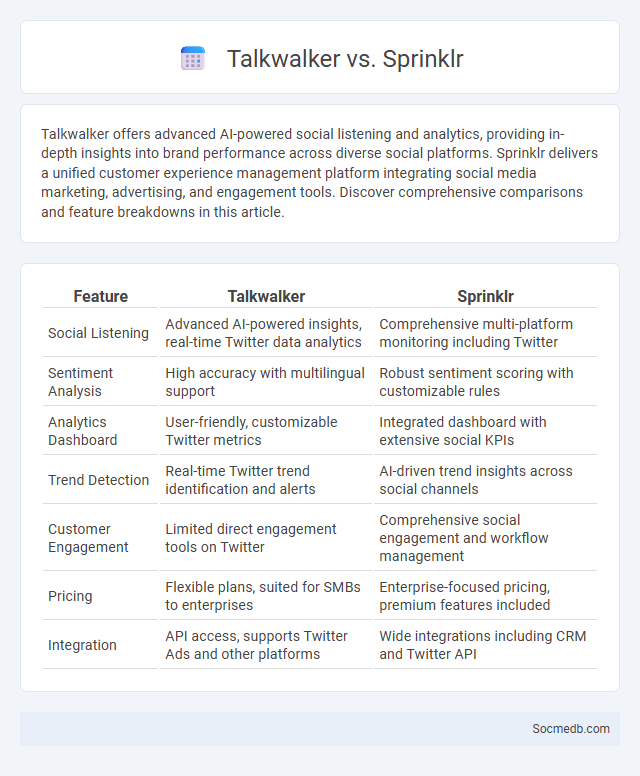
Photo illustration: Talkwalker vs Sprinklr
Talkwalker offers advanced AI-powered social listening and analytics, providing in-depth insights into brand performance across diverse social platforms. Sprinklr delivers a unified customer experience management platform integrating social media marketing, advertising, and engagement tools. Discover comprehensive comparisons and feature breakdowns in this article.
Table of Comparison
| Feature | Talkwalker | Sprinklr |
|---|---|---|
| Social Listening | Advanced AI-powered insights, real-time Twitter data analytics | Comprehensive multi-platform monitoring including Twitter |
| Sentiment Analysis | High accuracy with multilingual support | Robust sentiment scoring with customizable rules |
| Analytics Dashboard | User-friendly, customizable Twitter metrics | Integrated dashboard with extensive social KPIs |
| Trend Detection | Real-time Twitter trend identification and alerts | AI-driven trend insights across social channels |
| Customer Engagement | Limited direct engagement tools on Twitter | Comprehensive social engagement and workflow management |
| Pricing | Flexible plans, suited for SMBs to enterprises | Enterprise-focused pricing, premium features included |
| Integration | API access, supports Twitter Ads and other platforms | Wide integrations including CRM and Twitter API |
Introduction to Social Listening Tools
Social listening tools analyze online conversations, monitoring keywords, brand mentions, and sentiment across social media platforms to provide real-time insights. These tools help you understand audience preferences, track competitor activity, and identify emerging trends for strategic decision-making. Utilizing social listening enhances your brand reputation management and customer engagement by responding promptly to feedback.
Overview: Talkwalker vs Sprinklr
Talkwalker and Sprinklr both offer powerful social media analytics platforms designed to help businesses monitor brand presence and customer engagement across multiple channels. Talkwalker's AI-driven sentiment analysis and image recognition provide in-depth insights into consumer perception, while Sprinklr excels in unified customer experience management by integrating social media listening with customer care and marketing automation. Understanding your specific needs will help you determine whether Talkwalker's advanced analytics or Sprinklr's comprehensive customer experience platform aligns better with your social media strategy.
Key Features Comparison
Social media platforms offer diverse key features such as content sharing, real-time messaging, and algorithm-driven feeds tailored to user preferences. Instagram emphasizes visual storytelling through images and short videos, TikTok specializes in short-form engaging video content, while Facebook provides a comprehensive experience with groups, events, and marketplace functionalities. Understanding these key feature differences allows you to choose the platform that best aligns with your communication goals and audience engagement strategies.
Data Coverage and Accuracy
Social media platforms collect vast amounts of data from billions of users globally, offering comprehensive coverage across demographics, interests, and behaviors. The accuracy of this data relies on algorithmic parsing of user-generated content, engagement metrics, and real-time updates, though it can be affected by misinformation, fake profiles, and privacy settings. Advanced AI and machine learning models improve the precision of data analysis, enabling businesses and researchers to extract actionable insights with higher reliability.
Real-Time Analytics and Insights
Real-time analytics in social media platforms enable businesses to monitor user interactions and engagement instantly, providing valuable insights for optimizing content and campaigns. By leveraging advanced algorithms and AI-driven tools, brands can track trends, sentiment, and audience behavior as they happen, enhancing responsiveness and customer experience. These insights empower marketers to make data-driven decisions, improve targeting accuracy, and maximize ROI in dynamic social environments.
User Interface and Usability
Effective social media platforms prioritize a clean, intuitive user interface to enhance usability and user engagement. Features such as easy navigation, responsive design, and accessible controls ensure users can interact seamlessly across devices. Optimizing these elements reduces friction, increases content consumption, and boosts user retention rates.
Integration Capabilities
Social media platforms offer extensive integration capabilities that enable seamless connectivity with various applications and marketing tools, enhancing user engagement and data synchronization. Your brand can leverage APIs, plugins, and third-party services to unify content management, advertising campaigns, and analytics across multiple channels effectively. These integration features boost operational efficiency and provide comprehensive insights into audience behavior and performance metrics.
Pricing Structure and Plans
Social media platforms typically offer tiered pricing structures, including free basic plans with limited features, and premium subscriptions that unlock advanced tools for businesses and creators. Pricing plans often vary based on user access levels, ad credits, analytics depth, and customer support quality. Companies like Facebook Business Suite, LinkedIn Premium, and Twitter Blue provide scalable options to cater to diverse marketing and engagement needs.
Ideal Use Cases and Target Users
Social media platforms are ideal for brand awareness, customer engagement, and targeted advertising, effectively reaching diverse audiences with tailored content. Businesses targeting millennials and Gen Z benefit from interactive features like stories, live videos, and influencer partnerships to boost visibility and conversion rates. Nonprofits and community organizations leverage social media for advocacy, event promotion, and building supportive networks among niche user groups.
Conclusion: Choosing the Best Social Listening Tool
Selecting the best social listening tool depends on factors such as real-time data accuracy, integration capabilities with existing platforms, and comprehensive sentiment analysis. Tools like Brandwatch, Sprout Social, and Hootsuite offer robust analytics, customizable dashboards, and multi-channel monitoring essential for actionable insights. Prioritizing these features ensures businesses effectively track brand reputation, customer feedback, and emerging trends across social media channels.
 socmedb.com
socmedb.com